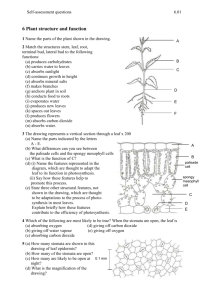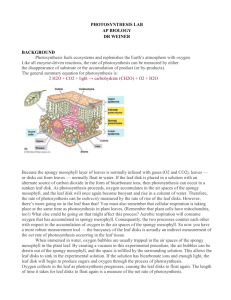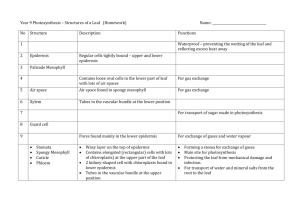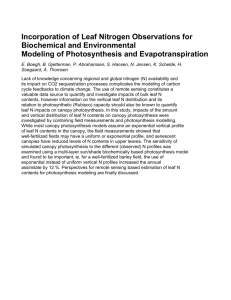Photosynthesis Lab: Floating Leaf Disk Assay
advertisement
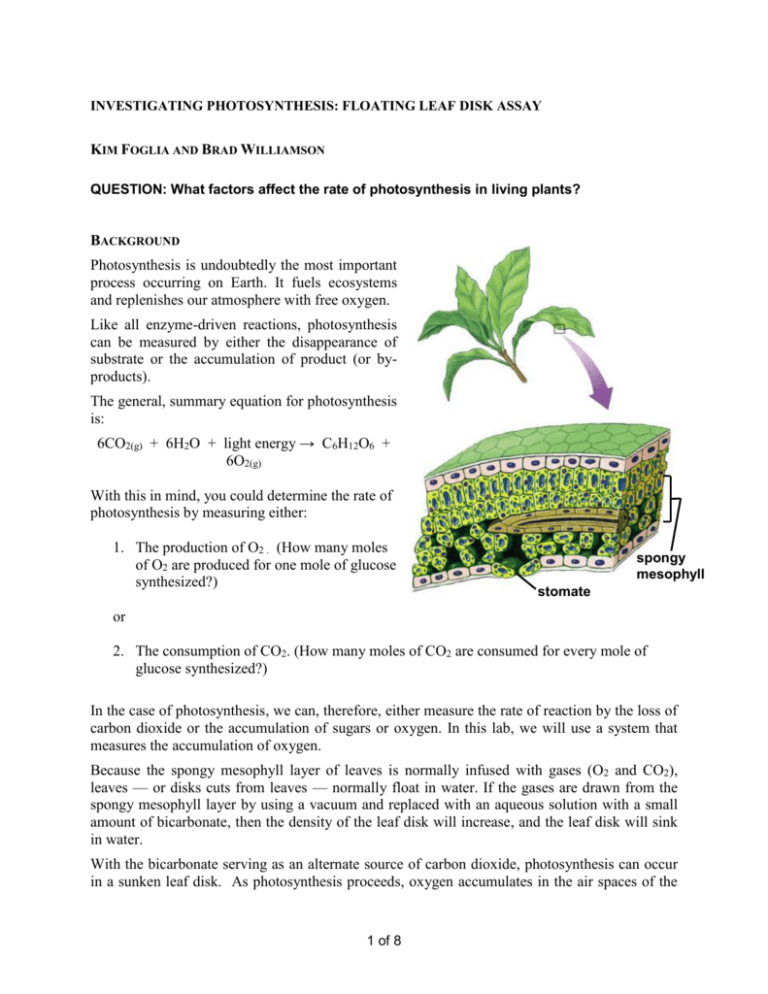
INVESTIGATING PHOTOSYNTHESIS: FLOATING LEAF DISK ASSAY KIM FOGLIA AND BRAD WILLIAMSON QUESTION: What factors affect the rate of photosynthesis in living plants? BACKGROUND Photosynthesis is undoubtedly the most important process occurring on Earth. It fuels ecosystems and replenishes our atmosphere with free oxygen. Like all enzyme-driven reactions, photosynthesis can be measured by either the disappearance of substrate or the accumulation of product (or byproducts). The general, summary equation for photosynthesis is: 6CO2(g) + 6H2O + light energy → C6H12O6 + 6O2(g) With this in mind, you could determine the rate of photosynthesis by measuring either: 1. The production of O2 . (How many moles of O2 are produced for one mole of glucose synthesized?) spongy mesophyll stomate or 2. The consumption of CO2. (How many moles of CO2 are consumed for every mole of glucose synthesized?) In the case of photosynthesis, we can, therefore, either measure the rate of reaction by the loss of carbon dioxide or the accumulation of sugars or oxygen. In this lab, we will use a system that measures the accumulation of oxygen. Because the spongy mesophyll layer of leaves is normally infused with gases (O2 and CO2), leaves — or disks cuts from leaves — normally float in water. If the gases are drawn from the spongy mesophyll layer by using a vacuum and replaced with an aqueous solution with a small amount of bicarbonate, then the density of the leaf disk will increase, and the leaf disk will sink in water. With the bicarbonate serving as an alternate source of carbon dioxide, photosynthesis can occur in a sunken leaf disk. As photosynthesis proceeds, oxygen accumulates in the air spaces of the 1 of 8 spongy mesophyll and the leaf disk will once again become buoyant and rise in a column of water. Therefore, the rate of photosynthesis can be indirectly measured by the rate of rise of the leaf disks. However, there’s more going on in the leaf than that! You must also remember that cellular respiration is taking place at the same time as photosynthesis in plant leaves (remember plant cells have mitochondria, too!). Aerobic respiration will consume oxygen that has accumulated in spongy mesophyll. Consequently, the two processes counter each other with respect to the accumulation of oxygen in the air spaces of the spongy mesophyll. So now we have a more robust measurement tool — the buoyancy of the leaf disks is actually an indirect measurement of the net rate of photosynthesis occurring in the leaf tissue. LEARNING OBJECTIVES To design and conduct an experiment to explore the effect of certain factors, including different environmental variables, on the rate of cellular respiration. To connect and apply concepts, including the relationship between cell structure and function (chloroplasts); strategies for capture, storage, and use of free energy; diffusion of gases across cell membranes; and the physical laws pertaining to the properties and behaviors of gases. GENERAL SAFETY PRECAUTIONS You must wear safety glasses or goggles, aprons, and gloves during this investigation(s) because you will be working in close proximity to exposed light bulbs that can easily shatter. Take care and caution to keep your solutions away from the electrical system powering your light source. Follow your instructor’s instructions. If you investigate temperature as a variable in part III, there is no need to heat any solution beyond 50-60 degrees Celsius. Do not work in the laboratory without your teacher’s supervision. Part I: Getting Started To study photosynthesis, you need a good understanding of the properties of light. Prepare for this laboratory by reviewing your knowledge of light and how it interacts with matter. In addition to your textbook, the Concord Consortium has a Java-based web activity that will review the properties of light and how visible light interacts with matter in the process of photosynthesis. This multistep activity uses visualizations, animations, and a molecular modeling engine that does an excellent job of making abstract concepts understandable. To explore this activity enter these terms in your search engine: “concord consortium molecular workbench photosynthesis” 2 of 8 While going through this activity, record questions that come to you in your laboratory notebook. These questions and others that occur to you while doing part II can serve as a basis for your own investigation in part III. Part II: An Introduction to the Floating Leaf Disk Technique for Measuring the Rate of Photosynthesis In this part of the lab, you will be introduced to the floating disk measurement technique. Later you will apply this technique (or you may choose to use computer-based probe ware), but these instructions focus on the leaf-disk technique) to investigate your own research question related to how a variable of your choosing affects the rate of photosynthesis. It is important for you to develop a few skills during this part of the investigation in order to carry out your own. For the floating disk technique, the most challenging skill is getting the disks to sink. Don’t just watch someone do this; make sure you can get the disks to sink as well. MATERIALS: Baking soda (sodium bicarbonate) Hole punch Liquid soap 2 clear plastic cups 2 plastic syringes — without needle! (10cc or larger) Timer Light source Living leaves (spinach, ivy, etc.) Oxygen bubbles are usually trapped in the air spaces of the spongy mesophyll in the plant leaf. By creating a vacuum in this experimental procedure, the air bubbles can be drawn out of the spongy mesophyll, which is then infiltrated by the surrounding solution. This allows the leaf disks to sink in the experimental solution. If the solution has bicarbonate ions and enough light, the leaf disk will begin to produce sugars and oxygen through the process of photosynthesis. Oxygen collects in the leaf as photosynthesis progresses, causing the leaf disks to again float. This procedure indirectly measures the net rate of photosynthesis. 3 of 8 PROCEDURE 1. Prepare 300 mL of 0.2% bicarbonate solution for each trial. This can be done by dissolving 1/8 teaspoon of baking soda in 300 mL of water. The bicarbonate will serve as a source of carbon dioxide for the leaf disks while they are in the solution. 2. Pour the bicarbonate solution into a clear plastic cup to a depth of about 3 cm. Label this cup “With CO2”. Fill a 2nd cup with only water to be used as a control group. Label this cup “Without CO2”. Throughout the rest of the procedure you will be preparing material for both cups, so do everything in parallel to prepare material for both cups simultaneously. 3. Using a pipette, add 1 drop of a dilute liquid soap solution to the solution in each cup. It is critical to avoid suds. If either solution generates suds, then dilute it with more bicarbonate or water solution. The soap acts as a surfactant or “wetting agent” — it wets the hydrophobic surface of the leaf allowing the solution to be drawn into the leaf and enabling the leaf disks to sink in the fluid. 4 of 8 4. Using a hole punch, cut 10 or more uniform leaf disks for each cup. Avoid major leaf veins. (The choice of plant material is perhaps the most critical aspect of this procedure. The leaf surface should be smooth and not too thick, therefore, leaves with hairy surfaces must be avoided. Ivy and spinach work well, but many others do as well. Differences between plants may be one of the ideas that you may want to investigate later in Part III.) 5. You must now draw the gases out of the spongy mesophyll tissue and infiltrate the leaves with the sodium bicarbonate solution. To do this: a. Remove the piston or plunger from both syringes. Place the 10 leaf disks into each syringe barrel. b. Replace the plunger but be careful not to crush the leaf disks. Push in the plunger until only a small volume of air and leaf disk remain in the barrel (<10%). c. Pull a small volume (5 cc’s) of sodium bicarbonate solution into one syringe and a small volume of water into the other syringe. Tap the syringe to suspend the leaf disks in the solution. d. You now want to create a vacuum in the plunger to draw the air out of the leaf tissue. Create the vacuum by holding a finger over the narrow syringe opening while drawing back the plunger. Hold this vacuum for about 10 seconds. While holding the vacuum, swirl the leaf disks to suspend them in the solution. Now release the vacuum by letting the plunger spring back. The solution will infiltrate the air spaces in the leaf disk, causing the leaf disks to sink in the syringe. If the plunger does not spring back, you did not have a good vacuum, and you may need a different syringe. You will probably have to repeat this procedure 2-3 times in order to get the disks to sink. (If you have any difficulty getting your disks to sink after about 3 evacuations, it is usually because there is not enough soap in the solution. Try adding a few more drops of soap.) Placing the disks under vacuum more than three times can damage the disks. 5 of 8 6. Pour the disks and the solution from the syringe into the appropriate clear plastic cup. Disks infiltrated with the bicarbonate solution go in the “With CO2” cup, and disks infiltrated with the water go in the “Without CO2” cup. 7. Place both cups under the light source and start the timer. At the end of each minute, record the number of floating disks. Then swirl the disks to dislodge any that stuck against the side of the cups. Continue until all of the disks are floating in the cup with the bicarbonate solution. NOTE ABOUT LIGHT SOURCES: We have found that a strong light source is necessary for success in this procedure. Some of the best results have been obtained when placing the cups of leaf disks on the bed of an overhead projector. Another inexpensive light source is the “Work Spotlights” that you can purchase from various box stores coupled with 100 watt equivalent compact fluorescent bulbs. 8. Repeated testing of this procedure has shown that the point at which 50% of the leaf disks are floating (the median) should be used as the point of reference for this assay when comparing different experimental treatments. The 50% point, or ET50, provides a greater degree of reliability and repeatability for this procedure. Extrapolate this point from the graph you construct from your data. 6 of 8 PART III: DESIGNING AND CONDUCTING YOUR OWN INVESTIGATION 1. Once you have mastered the floating disk technique, you will design an experiment to test another variable that might affect the rate of photosynthesis. Some ideas (but don’t limit yourself to just these!) include: Environmental Variables Light intensity (brightness) Light color (how do you explain the fact that plants are green and that chlorophyll doesn’t absorb green light?) Temperature Bicarbonate concentration (CO2 source) Direction of incoming light pH of solution Plant or Leaf Variables Leaf color (chlorophyll amount) Leaf size Stomata density Stomata distribution Light starved leaves vs. leaves kept in bright light Shade leaves vs. sunlit leaves Type of plant Leaf age Leaf variegation Role of respiration in plants along with photosynthesis—measuring gross photosynthesis 7 of 8 Method Variables (These variables may not effect photosynthesis but are still important to investigate) Size of leaf disk Depth of bicarbonate solution Methods of cutting disks Leaf disk overlap Soap amount How many times can the procedure be repeated with the same disks? How long can the disks remain sunk in the solution—can they be stored overnight? Method of data collecting 2. Consider combining variables. For instance an investigation of light intensities affect on the rate of photosynthesis could generate a “photosynthesis light response curve”. This is a form of measurement itself. How do you think a light response curve for a shade grown leaf compares to that of a sun grown leaf? Comparing light response curves is a standard research technique in plant ecological physiology. ET50 1/ET50 3. When you compare the ET50 across treatments, you will discover that there is an inverse relationship between ET50 and the rate of photosynthesis — ET50 goes down as rate of photosynthesis goes up which plots a graph with a negative slope. This creates a seemingly backwards graph when plotting your ET50 data across treatments. To correct this representation and make a graph that shows increasing rates of photosynthesis with a positive slope, the ET50 term can be modified by taking its inverse, or 1/ ET50. This creates a more traditional direct relationship graph. inverse relationship direct relationship 4. Don’t forget to include other appropriate data analyses as you prepare and study your discussion and conclusions. In particular for this investigation, you should somehow indicate the variability in your data. The ET50 measurement is calculated from the median. To indicate the spread of your data, you could use error bars around the ET50 point that express that variation---or you might consider using box and whisker plots. 5. Prepare a lab report / miniposter for a classroom peer review presentation. Check in chapter [X] of this lab manual for guidance on this. 8 of 8



